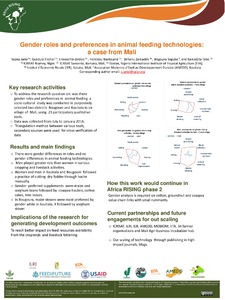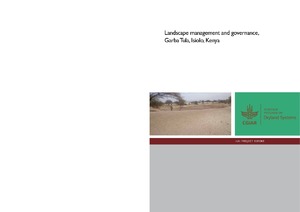Gender analysis in agricultural research : Proceedings international workshop, Palmira, Valle del Cauca, Colombia, 1991
Gender bukan tabu: catatan perjalanan fasilitasi kelompok perempuan di Jambi
Gender strategy: CGIAR Research Program on Water, Land and Ecosystems
WLE’s Gender Strategy sets out a path for the program to engage in pioneering research that generates findings and catalyzes action to address the gender-based challenges facing women and men, who are dependent on water, land and ecosystems for their livelihoods, food, nutrition and water security, and incomes. The strategy starts out and tests the hypothesis that gender equity promotes sustainable agriculture in vibrant ecosystems.
Gendered effects of Contagious Bovine Pleuropneumonia (CBPP) occurrence and control in a pastoral community in Ijara sub county, northeastern Kenya
Human and animal vaccination delivery to remote nomadic families, Chad
Vaccination services for people and livestock often fail to achieve sufficient coverages in Africa's remote rural settings because of financial, logistic, and service delivery constraints. In Chad from 2000 through 2005, we demonstrated the feasibility of combining vaccination programs for nomadic pastoralists and their livestock. Sharing of transport logistics and equipment between physicians and veterinarians reduced total costs. Joint delivery of human and animal health services is adapted to and highly valued by hard-to-reach pastoralists.
Is reliable water access the solution to undernutrition? A review of the potential of irrigation to solve nutrition and gender gaps in Africa South of the Sahara
Interventions aimed at increasing water availability for livelihood and domestic activities have great potential to improve various determinants of undernutrition, such as the quantity and diversity of foods consumed within the household, income generation, and women’s empowerment. However, current evidence on the topic is diluted across many different publications. This paper aims to connect the dots and review the literature available on the linkages between irrigation and food security, improved nutrition, and health.
Landscape management and governance, Garba Tula, Isiolo, Kenya
L'Impact de la crise economique sur les systemes agricoles et la changement du couvert forestier dans la zone forestiere humide du Cameroun
A sample survey of 648 households was conducted in 54 villages in the humid forest zone of Cameroon to understand the effect of the economic crisis (dating from 1986) and the 1994 currency devaluation on the practices of small farmers, and the effect of these practices on forest cover change. Four hypotheses were tested concerning: the balance between plantation crop and food crop production; the degree of market-orientation of food crop production; the gender division of labour; and the degree of dependence on non-timber forest products (NTFPs).
Livestock and Women's Livelihoods: A Review of the Recent Evidence
This paper synthesises evidence of the contributions that livestock make to the livelihoods of poor women in sub-Saharan Africa and South Asia and identifies factors that enhance or constrain livestock-related opportunities for women. We apply a gender lens to three livestock-related pathways out of poverty—securing, building and safeguarding livestock assets; increasing and
Pastoral women’s land rights and village land use planning in Tanzania: Experiences from the sustainable rangeland management project
In pastoral societies women face many challenges. Some describe these as a ‘double burden’ – that is, as pastoralists and as women. However, pastoral women may obtain a significant degree of protection from customary law even if customary institutions are male-dominated. In periods of change (economic, social, political), this protection may be lost, and without protection from statutory laws, women are in danger of “falling between two stools” (Adoko and Levine 2009).







